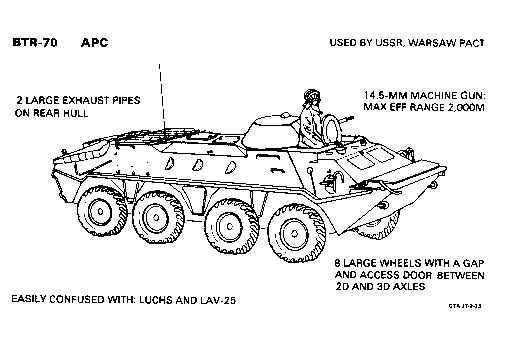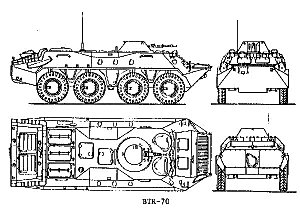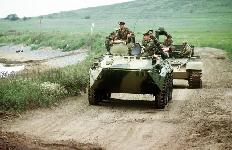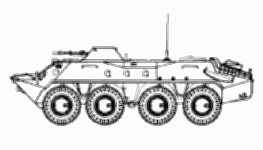



The BTR-70 was first seen in 1978 and so was given the preliminary designation BTR M1978, and was first shown in public during a Moscow parade in 1980. A successor vehicle to the BTR-60P, both vehicles have the same turret armament, while the BTR-70 has two upgraded 8-cylinder 120-hp gasoline engines which give improvements in power-to-weight ratio. Other modifications include improvement to vision for the troops, additional firing ports and improved armor protection. The BTR-70 has a slightly longer hull, and features a recognizable gap between the front and rear sets of road wheels. Triangular-shaped access doors are located in this space on both sides of the vehicle and provide side entrance and exit for troops, rather than only from the top as in the BTR-60PB. Also, the wave deflector is mounted differently from the BTR-60PB on the BTR-70.
Although the BTR-70 offered a number of improvements over the BTR-60, continuing shortcomings included the pair of gasoline engines and poor means of entry and exit. While the BTR-60PB had only top hatches for troop entrance and exit, the BTR-70 incorporates triangular access doors in the on both sides of the vehicle. The troop compartment accomodates six infantry men, each provided with a firing port and vision block. As with the BTR-60PB and BRDM-2, the BTR-70 has a small conical turret armed with a 14.5-mm KPT machine gun and a coaxial 7.62-mm PKT machinegun. The BTR-70 is fully amphibious, propelled by a single water-jet at the rear of the hull. Before entering the water a trim vane is erected at the front and bilge pumps switched on.
Like the BTR-60PB, the BTR-70 has good cross-country capability, high road speed, and large troop-carrying capacity. Its versatility and amphibious capability are also advantages. The primary disadvantage is its relatively light armor protection, although it has been reported that the bow section possibly incorporates special layered armor.
VARIANTS
- BTR-70 M1986/1 -- several improvements were made including: improved turret with high angle of fire weapons and smoke mortars, modified wave deflector, additional side armor brackets, and top mounted firing ports.
- BTR-70Kh -- used to conduct chemical reconnaissance. SPR-2 A proximity fuse jammer mounted on the BTR-70 chassis. This vehicle is the successor to the tracked SPR-1. This jammer is designed to prematurely detonate proximity fuzzed artillery rounds.
- BTR-70MS [Maschina Svyazi - signals vehicle] -- used as a communications support vehicle.
- BTR-70KShM [ Komandno-Shtabnaya Maschina - command and control vehicle] -- used as a mobile command post vehicle.
- BREM [Bronirovannaya Remontno-Evakuatsionannaya Mashina - armored repair and recovery vehicle] consists of a BTR-70 with the turret removed and replaced with a crane and other repair equipment.
Specifications
|
| Main Armament (caliber, model) | 14.5-mm KPVT MG |
| range, effective (m) | 2000 ground, 1400 air |
| rate of fire (rpm) sustained/maximum | 80/600 |
| elevation/traverse (degrees) | -5 to 30/360 |
| basic load | 500 |
| Secondary Armament | 7.62-mm PKT MG |
| range, effective (m) | 1000 |
| rate of fire, cyclic/practical (rpm) | 650/250 |
| penetration (mm @ m range) | 8 @ 500 m |
| basic load | 2000 |
| vehicle characteristics |
| night sights |
| commander | IR |
| gunner |
| driver | IR |
| speed, road/off-road (kph) | 80/45/10 |
| range, road/off-road (km) | 450 |
| trench crossing (width x height m) | 2x0.8 |
| grade x side slope (degrees) | 31x17 |
| ground clearance (mm) | 475 |
| fording (m) | swim |
| armor, hull/turret (mm) | 10/7 |
| weight (mt) | 11.5 |
| dimensions (LxWxH m) | 7.85x2.8x2.45 |
| crew | 2 + 8 |





Sources and Methods
http://www.fas.org/man/dod-101/sys/land/row/btr-70.htm
Maintained by Robert Sherman
Originally created by John Pike
Updated Saturday, October 16, 1999 12:09:21 PM










